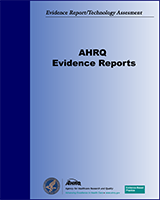This publication is provided for historical reference only and the information may be out of date.
Evaluation of Technologies for Identifying Acute Cardiac Ischemia in Emergency Departments
Evidence Reports/Technology Assessments, No. 26
Authors
Investigators: Joseph Lau, MD, Principal Investigator, John PA Ioannidis, MD, Ethan Balk, MD, MPH, Catherine Milch, MD, Priscilla Chew, MPH, Norma Terrin, PhD, Thomas A Lang, MA, Deeb Salem, MD, and John B Wong, MD.ReadStructured Abstract
Objectives:
Acute cardiac ischemia (ACI) includes unstable angina pectoris (UAP) and acute myocardial infarction (AMI) and is the leading cause of death in the United States. The rapid and accurate diagnosis of ACI has substantial clinical and economic benefits. We have updated a 1997 report that evaluated the diagnostic technologies for identifying patients with ACI in the emergency department (ED), where most patients with ACI enter the health care system.
Search Strategy:
We conducted a comprehensive MEDLINE search of the English-language literature published between 1966 and December 1998. Additional articles were retrieved from references cited in the 1997 report and bibliographies of retrieved articles. Search terms included those related to the diagnosis of ACI, AMI, and UAP in the ED and to the following technologies: prehospital electrocardiography (ECG), continuous/serial ECG, nonstandard leads ECG, exercise stress ECG, the ACI Time-Insensitive Predictive Instrument (ACI-TIPI), the Goldman chest pain protocol, biomarkers, sestamibi myocardial perfusion imaging, echocardiography, and computer-based decision aids.
Selection Criteria:
We reviewed studies that assessed the diagnostic performance of these technologies and their impact on health care delivery. Study populations were adult patients presenting to EDs with signs and symptoms suggestive of ACI.
Data Collection and Analysis:
Study test performance or clinical impact data were abstracted. Each study was also assessed for its applicability and methodological quality. Evidence tables were constructed for the technologies. Meta-analyses were conducted to summarize the test performance and the clinical impact of the technologies. A decision and cost-effectiveness analysis was performed to evaluate the tradeoff between costs associated with a technology and its triage accuracy.
Main Results:
We screened 6,667 MEDLINE titles, retrieved 407 articles, and included 105 studies in the analysis. Most studies evaluated the diagnostic performance of the technologies; a few evaluated the clinical impact of routine use. In the general ED setting, only ACI-TIPI was shown to be able to identify most of the patients with ACI and to reduce unnecessary hospitalizations. Single measurement of biomarkers at presentation to the ED has poor sensitivity for AMI although most biomarkers have high specificity. Serial measurements can greatly increase the sensitivity for AMI while maintaining excellent specificity. However, biomarkers cannot identify most UAP.
Seventeen technologies and four combinations of technologies were evaluated in the cost-effectiveness analysis. Through the use of diagnostic performance data, the combination of troponin T and echocardiography was shown to have the best triage accuracy for patients with ACI and to be the most cost-effective. Through the use of clinical impact data, ACI-TIPI was shown to have the best triage accuracy for patients with ACI and to be the most cost-effective technology.
Conclusions:
A diverse array of technologies with varying degrees of diagnostic accuracy is available for use in general or selected patient populations to diagnose ACI in the ED.
No single technology is able to identify all ACI patients and at the same time avoid hospitalizing many patients without ACI.
Most studies evaluated patients with AMI rather than ACI.
Research on the diagnosis of ACI in the ED is characterized by great heterogeneity among studies because of the large number of variables that can be studied. This heterogeneity has resulted in fragmented evidence that is not easily synthesized into a coherent whole.
Some technologies (e.g., echocardiography, sestamibi imaging, exercise ECG) remain underevaluated, and little research has been done on the value of sequential testing or on test combinations.
The number of studies on the clinical impact of these technologies is inadequate.
The quality of reporting by studies in this area needs to be improved.
Prepared for: Agency for Healthcare Research and Quality, U.S. Department of Health and Human Services.1 Contract No. 290-97-0019. Prepared by: New England Medical Center Evidence-based Practice Center.
Suggested citation:
Lau J, Ioannidis J, Balk E, et al. Evaluation of Technologies for Identifying Acute Cardiac Ischemia in Emergency Departments. Evidence Report/Technology Assessment Number 26. (Prepared by The New England Medical Center Evidence-based Practice Center under Contract No. 290-97-0019) AHRQ Publication No. 01-E006, Rockville, MD: Agency for Healthcare Research and Quality. May 2001.
On December 6, 1999, under Public Law 106-129, the Agency for Health Care Policy and Research (AHCPR) was reauthorized and renamed the Agency for Healthcare Research and Quality (AHRQ). The law authorizes AHRQ to continue its research on the cost, quality, and outcomes of health care and expands its role to improve patient safety and address medical errors.
This report may be used, in whole or in part, as the basis for development of clinical practice guidelines and other quality enhancement tools, or a basis for reimbursement and coverage policies. AHRQ or U.S. Department of Health and Human Services endorsement of such derivative products may not be stated or implied.
The authors of this report are responsible for its content. Statements in the report should not be construed as endorsement by the Agency for Healthcare Research and Quality or the U.S. Department of Health and Human Services of a particular drug, device, test, treatment, or other clinical service.
- 1
2101 East Jefferson Street, Rockville, MD 20852. www
.ahrq.gov
